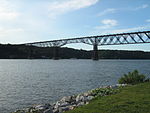Hudson Valley Rail Trail

The Hudson Valley Rail Trail is a paved 4-mile (6.4 km) east–west rail trail in the town of Lloyd in Ulster County, New York, stretching from the Hudson River through the hamlet of Highland. The trail was originally part of the Poughkeepsie Bridge Route, a rail corridor that crossed the Hudson via the Poughkeepsie Bridge. Controlled by a variety of railroads throughout the 19th and 20th centuries, the bridge was damaged and became unusable after a May 8, 1974 fire. By the 1980s, the corridor's then-owner, Conrail, had routed all rail traffic in the region north through Selkirk Yard and was eager to relieve itself of the bridge and adjoining rights-of-way. In 1984, it sold the entire property for one dollar to a felon who did not maintain it or pay taxes on it. The section of the corridor west of the Hudson was seized by Ulster County in 1991 and transferred to the town of Lloyd. During the 1990s, a broadband utility seeking to lay fiber optic cable paid the town to pass through the former corridor. The town used part of its payment to pave the route and open it as a public rail trail in 1997. The creation of the trail was supported by a local Rotary club, which built a pavilion along the trail. The pavilion includes a donated antique caboose. While the trail originally ended at Route 44–55, it was extended eastward between 2009 and 2010, intersecting Route 9W and continuing to the Poughkeepsie Bridge. The extension was paid for by stimulus funding. The bridge, now a pedestrian walkway called Walkway Over the Hudson, connects the trail with the Dutchess Rail Trail to the east, creating a 30-mile (48 km) rail trail system that spans the Hudson. The trail is expected to be extended west, where it will border Route 299. As it passes through Highland, the trail is carried by several bridges, connects to four parking areas, and traverses a wetlands complex. The trail forms part of the Empire State Trail.
Excerpt from the Wikipedia article Hudson Valley Rail Trail (License: CC BY-SA 3.0, Authors, Images).Hudson Valley Rail Trail
Hudson Valley Rail Trail,
Geographical coordinates (GPS) Address Nearby Places Show on map
Geographical coordinates (GPS)
| Latitude | Longitude |
|---|---|
| N 41.72342 ° | E -73.96983 ° |
Address
Hudson Valley Rail Trail
Hudson Valley Rail Trail
12528
New York, United States
Open on Google Maps





